Table of Contents
Podcasting - Online
~~REVEAL~~
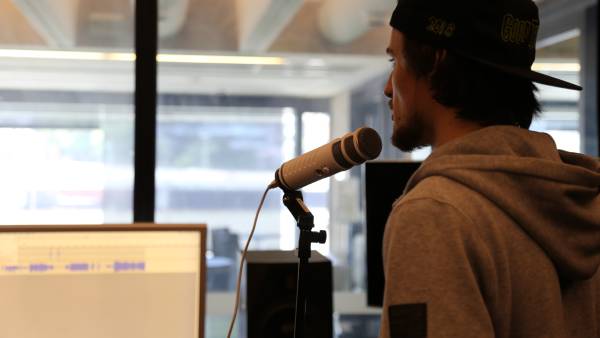
Re-developed for online presentation by Michelle Brown in June 2020.
Acknowledgement
We acknowledge Aboriginal and Torres Strait Islander peoples and their continuing connection to land and as custodians of stories for millennia. We respectfully acknowledge the land on which we all meet today, and pay our respects to elders past, present and emerging.
Summary
In this series of 3 online workshops focused on Podcasting we will cover;
Pre-Production - Research, what makes a popular podcast, finding a story/topic and creating an engaging channel
Production - Mics and sound, what gear do you need, understanding sound including capturing atmosphere, interviewing techniques.
Post-Production - Editing and hosting (free distribution options and metrics)
Skills Introduced
- Understanding of the basics of podcasts
- Identifying what makes good audio content
- Basic audio capture and editing skills
- Understanding of online hosting and distribution of podcasts
- How best to promote a podcast
Requirements & Preparation
You will need a computer with internet connection with headphones or speakers, inbuilt or external microphone for chatting and viewing the workshop on Zoom and a comfortable space.
Please ensure you have the following applications installed and tested before the session starts.
Online Video Communication App
We will be using Zoom for our online presentation.
Make sure you test your audio and video in Zoom before joining the workshop. Video is not necessary but audio will be!
Audio Editing App
We will be using Audacity for editing any audio during the workshop series, it is a free and open source software available cross platform.
We will go through the basics of Audacity during our sessions, just make sure to download in advance.
OHS & Online Safety
As we want to ensure your safety, we suggest only clicking on the links we have provided and if you have any weird pop ups or issues, please get in contact. Our Zoom sessions will have passwords implemented and we will send an email invite with the info before the session.
Please also be aware of your own health and safety and workplace set up. There are some resources available Works Safe QLD on workstations and well being.
WORKSHOP 1
Pre-Production
Ice-breaker and Introductions
Everyone to introduce themselves and talk about what they want to learn from the sessions, inducing any potential podcast ideas.
Discuss as a group;
- different types of podcasts people are listening to, why they like them
- how they subscribe to listen or follow their favourite podcasts
- what type of podcast topic they might be considering
- who has any previous experience with audio production
What is a Podcast?
Discuss the history and popularity of podcasting currently, how is it different to traditional media like radio.
"Podcast" is a blend of words, formed by combining “iPod” and “broadcast”. The term “podcasting” as a name was first suggested by The Guardian columnist and BBC journalist Ben Hammersley, who invented it in early February 2004 while writing an article for The Guardian newspaper.
Podcasts are audio files that can be downloaded automatically to a computer or mobile device. The revolutionary aspect of the podcast is that listeners simply subscribe (usually free of charge) to a podcast, and then as new audio files become available (episodes), they are automatically downloaded to our phone or computers to listen to on our own time.
- The audience has the freedom to listen on the go (e.g on smart phones, in the car)
- They can listen whenever they want
- They can be very topic specific, niche content that can connect a community around the world
A good example of building a community is My Favourite Murder and the Murderinos fan cult - https://www.myfavoritemurder.com/
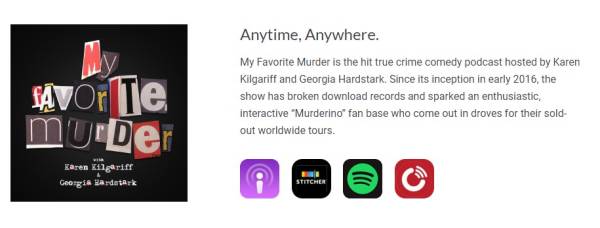
Some of the most popular podcasts such as Serial and S-Town attract audiences in the tens of millions around the world. In fact, it is Serial, made by the same people who produce the popular radio program This American Life which is attributed with the rise in popularity of podcasts - especially due to its attracting a traditional radio audience and introducing them to the format.
Many major media organisations (newspapers included) see that the podcast platform has a lot of potential to engage new and younger audiences and many have a “podcast first” policy on some stories, an example of this was the Australian newspaper’s Bowraville and The Teacher’s Pet podcast series.

Let's look at the current most popular Podcasts, the website Podtrac provides industry rankings, keep in mind ranking is based on Podtrac measurement data for Unique US Monthly Audience.
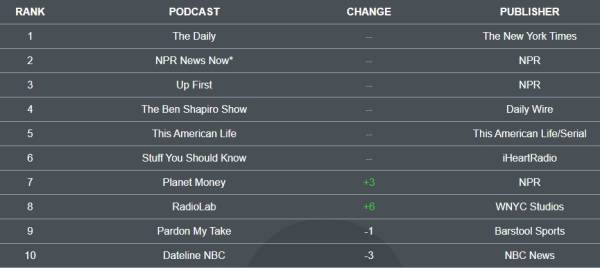
It's handy to see some of the most popular styles and publishers of podcasts, however we can also use Podcatchers to view popular ones, as they all usually have charts you can look through, for example Google Podcasts
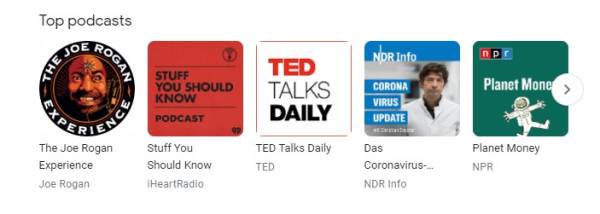
Subscribing to a Podcast

Let's talk more about podcatchers so you can get an idea of how the general podcast consumer is accessing. You may be familiar with RSS feeds if you've ever followed an online news service, but podcasts also use RSS feeds to keep subscribers up to date.
An RSS feed is how an audience can access a podcast's content. It allows your podcast to appear on any podcasting directories and your own website, every podcast needs one.
Just like any media that is hosted online, we need a way to track and listen to podcasts. Let's talk about some of the options for subscribing to a Podcast, this will help you understand how best to distribute your own.
Here's a few apps you can use to subscribe and listen;
- Apple Podcast app
- Google Podcast app
- Spotify
- The Podcast App
- Pocket Casts (in app purchases)
- Podcast Addict
- Podbean

If participants are very new to podcasting, find and subscribe to a podcast using one of the free apps. Getting to know how people are consuming podcasts is very helpful before you start producing your own!
Basic requirements
There are several things you will need to create a successful podcast, we'll cover things in more detail as we go but here's the basics;
- Content – engaging content is central to podcasting
- Recording equipment or access to - audio quality is still key even with beginner podcasting
- Editing software – for piecing together the recordings and optimizing for online hosting
- Host server – an internet server where you load your podcast audio episodes
- Host web page – this is usually a page on the on the host server's website where your audience finds your podcast and subscribes to it
- A digital strategy – can also be called a marketing or promotional plan. There are a huge amount of podcasts out there, you'll need some good strategies to cut through the clutter.
Listeners also need a way to receive a podcast.
- Most importantly they need to be connected to the Internet to download podcasts
- They need a podcatcher (such as iTunes, Google Podcast, Spotify). Once they have subscribed, most podcasters automatically download the new episodes to their devices.
- They will also need a computer or mobile device to listen back to the episodes once they are downloaded.
Podcast Content
Let's talk about the content side of things, do you already have an idea for a topic? Share with the group and let's think about how broad or narrow the idea might be, how can you focus or extend the idea to capture a dedicated audience.
Some key things you might want to think about initially are;
- Is this for fun or will you be looking to monetize?
- Are there other podcasts that cover similar (or identical!) topics, how will yours be different?
- How long will an episode of your podcast run for (will each week be the same or will you intersperse with extras or ‘minisode’ eps)
- Have you thought of a name that will stand out from the crowd? (Making sure to check if it’s already been used before you get too attached!)
- How often will your podcast run, weekly, monthly, intermittently? Will it be seasonal or continuous etc.
Great presentation skills, recording and editing skills along with good editorial skills (knowing what works in audio) will help you dive straight into producing a podcast, but you can also learn these pretty quickly and we'll cover the basics of these during our workshops.

Participants to spend some time writing down some answers to the following (use text edit or paper if they prefer);
- What kind of podcast do you want to create?
- How long? How often?
- Who is your target audience (Lay audience or industry specific? Vocab and level of explanation will be important for how you communicate based on the level of expertise you expect listeners to have)
- Tone: serious or light-hearted?
- How will you record it and edit it? (don't worry if you haven't thought about that yet, we'll go into this later)
- How will you promote it?
Podcast Styles
You can have your own style of podcast, but generally they will fall into one of the below broadcast formats, having a think about which style you might prefer for your own podcast may help you focus on the structure and content.
- The Interview style; usually featuring regular guests and interviews and may include a few hosts
- The Solo Podcast; run by one person and possible covering specific topics
- The Panel Show; a group of hosts discussing different topics relating to the podcasts main focus
- Conversational/Co-hosted podcast; similar to interview format but more casual
- Storytelling; could be historical content or fictional, can include one host or more
- Audio drama; similar to old-fashioned radio plays featuring sound design, multiple characters etc.
Episode Preparation
For great sounding audio content, preparation is key! Even if it's a loose idea for structure of the ep, but using a runsheet is super helpful to keep you organised and on track.
Some things you might need to think about when putting together the podcast;
Scripting; will you have dot points to refer to, no script at all and totally wing it, or fully scripted. Be mindful of fully scripting or winging it, you can sound like you're reading direct from a piece of paper - or with not notes can lose track of what you want to talk about.
Interviews; will you have anyone guest on your show? If you do, you may want to prepare a list of questions.
SFX & music (licensing); if you want to make your content engaging, you may want to think about sound effects and backing music.
Stings/pre-recorded elements; Creating an appealing podcast intro will help you start each show with a formula and introduce new listeners to who/what you cover.
Perhaps content warnings if your show is not suitable for younger audiences or features explicit/difficult content.

Let's run through this to get an idea of how you might be able to use it for your podcast preparation. Before the next online session, spend some time filling out on the computer with a word processing program (Open Office is free) with your idea for an episode of a podcast.
You can download a run sheet template
Legalities and Copyright
Because Podcasts are globally accessible, opposed to traditional media like radio and TV, they aren't bound as strictly to ACMA (Australian Communications and Media Authority) codes of practice, so rules around swearing and offensive material do not apply. However, all other broadcast laws and regulations do apply – such as defamation, copyright, racial vilification and so on, as podcasting is a form of publishing.
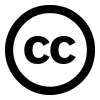
You can read through the Creative Commons 'Blog, Podcast, Vodcast and Wiki Copyright Guide for Australia' - https://creativecommons.org.au/publications/blogguide/
Different podcasting platforms have their own requirements when it comes to copyright material, read the fine print about copyrighted material in the terms of service as you begin to use a new platform to distribute your content.
Including music in your podcast can cause a bit of a headache, you need permissions from the artist or the right to broadcast via licensing, in Australia you would need to be covered by APRA AMCOS and PPCA.
Best to just use copyright free music or get written permission from any friends who may let you use their music (if they are on a label it may not be this easy mind you!).
Some more links on legal things to be aware of (some of this is US relevant though so keep that in mind);
https://medium.com/the-walkley-magazine/fair-dealing-for-australian-podcasters-6861290b414d
https://firemark.com/2013/05/14/9-tips-to-keep-your-podcast-legal/
Creative Commons Licensing
Free Music Archive has a good breakdown of licensing and copyright, plus music and soundtrack audio you can search for - http://freemusicarchive.org/License_Guide
Places to find copy-right free music:
Wrap Up

That's a wrap on our first session. Before next session there's a couple of things we'd like you to do.
As discussed in out Activity sections;
1. If you haven't subscribed to a podcast before, then please try doing so using one of the podcatchers we discussed.
2. Work out a podcast concept - if you're not sure yet, make something up.
Before next week it would be great if you can come up with;
- A name and brief synopsis about your podcast
- How long it may run for and how often
- Who is your target audience
3. Use the Run Sheet template to do up a dummy episode for your podcast idea

Workshop 2
During session 2 of this program we cover the recording and equipment side of Podcasting. Production - Mics and sound, what gear do you need, understanding sound including capturing atmosphere, interviewing techniques.
Recap Session 1
Let's quickly recap what was covered in session one and go through any of the activities participants were asked to take a look at including a dummy run sheet and podcast idea.
Production
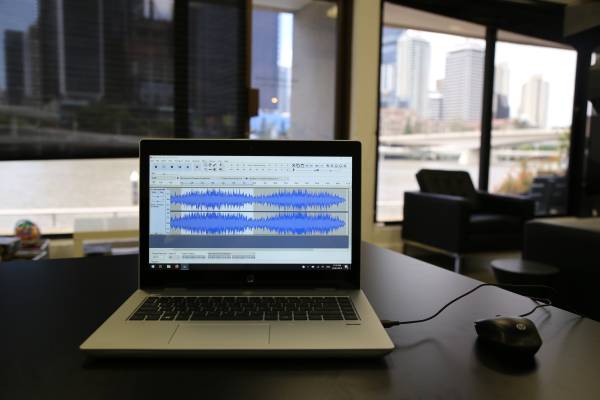
Putting together a home recording or portable podcast set up can be daunting, it's hard to know where to start, particularly when you start looking online for advice. You can fall down many a rabbit hole and end up back where you started, no clue on what to purchase and what you need.
We've found a few handy links online, but ultimately it comes down to how much you want to invest and what level of knowledge you have about sound and recording gear. Start basic is probably a good rule of thumb, you can always upgrade and spend more once you get more comfortable with the process.
It's also important to note that sound engineers and production people spend years learning this stuff, so we're not going to get through more than the basics today, and it will be up to you to continue to grow your audio knowledge. The State Library offers specific workshops on many audio programs and a Recording Studio induction for those interested in using the free facility at The Edge.
Resource; Ira Glass Video - https://www.youtube.com/watch?v=91FQKciKfHI
Gear

Image compiled from various online gear sites.
Requirements - Ability to record vocals with little sound interference is your main goal, if you're just starting out and don't have access to a studio, there is a basic list of things you'll need.
- Mic, leads and pop filter (XLR vs USB)
- Audio interface (may not require if you go with USB mic)
- Mic Stand
- Headphones
- Soundproofing (Your recording environment is key, you may need to deaden the sound of the room, not too much echo or road noise, aircon rattle etc.)
Extra items;
- Portable Audio Recorder
- Or mic/adapter for mobile phone
Also required is a computer to run the setup and audio editing software.
There's some great resources available on a website called Transom
It's up to you how much you want to spend, but we've looked at rough basic costs for a portable/home recording set up.
Basic starting costs;
- Basic Mic ($100 to $150)
- Mic Shield (from $50 to $89)
- Pop shield or mic sock ($10)
- Mic stand/s ($20 for desk stand and $20 for full stand)
- Mic lead (will come with USB mics, XLR leads from $20)
Resources;
https://podcastblastoff.com/post/How-to-Build-a-Podcast-Studio-on-Any-Budget
https://www.digitalmarketer.com/blog/podcast-equipment/
Recording with iPhone - https://www.guidingtech.com/audio-recording-apps-iphone/
Dolby mobile app - https://music.dolby.com/dolby-on/
Microphones
There are 4 main types of microphone polar patterns, which identify where and how much the mic will pick up.: cardioid, super cardioid, omni and figure 8.
- Cardioid: Imagine a Japanese fan coming from the tip of the mic. That’s the pattern it will hear sound from.
- Super Cardioid means the fan is not fully unfurled – a tighter pickup area.
- Omni means all around, from everywhere – think a globe around the mic as it’s pick up range.
- Figure 8; put the mic in the center of the 8 and it’s a visual to the pattern it will pick up – not much if anything from the side and everything in front and in back.
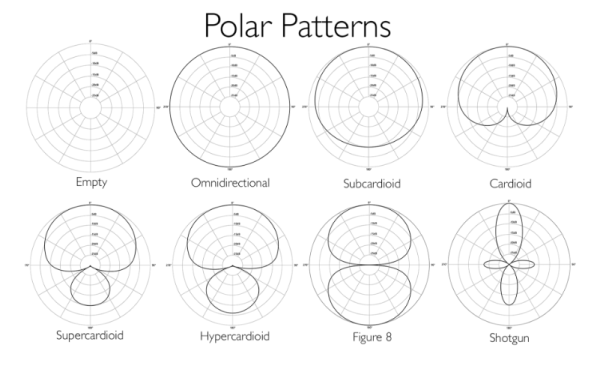
There are three different categories for mics: Dynamic, Condenser and Ribbon.
Mic technique is also very important, here's a quick guide on how best to position yourself - https://www.voices.com/blog/microphone_sweet_spot/
Plug in mics for iPhone -
https://www.podcastinsights.com/best-iphone-microphone/
Further resources -
https://thehub.musiciansfriend.com/audio-recording-buying-guides/buying-guide-microphones
https://reverb.com/au/news/what-are-the-basic-types-of-microphones-the-basics
MIC Technique
How close should I be to the microphone?
Microphones and voices are all different. About 10cm is a good starting point, but use the following points to find the right distance for you.
If you're too close to the microphone:
Your P, T, S and Q sounds might cause popping or hissing noises Your breathing will sound unnaturally loud Your voice might sound “boomy” and distorted Your volume levels will be difficult for the panel operator to control.
The slightest movement away from the mic will result in a noticeable change in your voice.
If you're too far away from the microphone:
You will sound as if you’re on the other side of the room Your voice will be difficult to understand The mic will pick up other unwanted noise in the studio Your voice will have a thin, echoing sound.
Interviewing Approach
Organising the interview The way you ask someone for an interview makes a big difference in whether they decide to talk to you or not. Interviews can take place either ‘in person’ or over the phone or internet.
The Step-by-step Approach
- Introduce yourself to the person and make it clear where you are from or who you are representing.
- Tell the person what this might be for and why you want to interview them.
- Tell the person what you will be asking them questions about.
- Be polite and friendly.
- Know exactly why you want to talk to them so you can communicate that clearly.
- Brief them. Tell them how long the interview will take, arrange an appropriate time and place to do the interview, be sure to get all their contact details and try and arrange to have them ring you at an appointed time.
- Build rapport: Have a chat, get to know them a little, BUT don't cover too much ground, leave that for the real interview.
- Confirm details and thank them for their time
Preparing Questions
When preparing questions, a good place to start is with the 5Ws and the H, then expand from there.
Who, what, where, why, when & how?
Write your questions down as this will help you avoid a mental blank, but in order to sound less rehearsed you might like to use simple bullet points.
Your first question is very important and should set the tone for the interview, cutting to the main angle you wish to explore.
Don’t ask ‘closed’ questions. A closed question is a question that will get a ‘yes’ or ‘no’, or one sentence answer. These answers are usually not that useful (particularly in radio that relies on sound).
Conducting the Interview
Learning how to produce a good interview takes time and experience, however following a few simple techniques can help.
- Stay focused on what you want to get from the interview.
- Tell listeners the person’s name and position, what you are going to talk about.
- Questions should be as short as possible to give the respondent time to answer.
- Question Delivery: should be clear, concise and sound interested
- Remember a good interviewer must be a good listener.
- If the talent is talking for too long on a subject, it is appropriate to move on as politely as you can.
- Listen to answers: Follow up on interesting points. Ask other questions as they might arise, based on what the interviewee says or something new that might come to you on the spur of the moment.
- Keep it Simple: don't let the interviewee generalise or use technical terms - make them explain, be attentive.
- Keep your questions and comments at a level of broad comprehension (unless circumstances specifically require it).
- Look interested to the interviewee: Don't murmur, instead use facial expressions and nod your head to encourage them to tell you more.
- Last Question/ Closing. When you have covered the subject, finish the interview. Use “Finally,,” or “It’s been a pleasure talking to you…” to wrap it up.
Intros and Stings
Promotional items included in your broadcast/podcast like a show introduction or 'sting' help keep listeners engaged with short professional audio that can be used in a variety of ways. They can be dispersed into a podcast and used elsewhere online as promotion.
Some of the things you want to cover in your podcast promo are;
- Name of your podcast
- Host of the podcast
- Purpose or tagline of the podcast
- Any other important info like sponsors or disclaimers
If it's pre-recorded then you want to keep it relevant for every podcast episode, after you play the intro/sting, you can then introduce the episode topic, any guests or other relevant info.
A sting might just be a 5 second reminder about the podcast and host, for example; 'You're listening to Jane and John on Podcast 123, discussing the best movies ever made'
These can help in the editing process, to help end a segment or break up a long topic.

Before the next session, participants should create a script for a show promotion and record that with whatever devices they may have available, this might just be a mobile phone and recording app. We'll use the recording during the next session to look at editing with free software, Audacity.
WORKSHOP 3
During session 3 we will cover Post-Production, including editing audio, creating soundbeds and using effects, and how to host and distribute your podcast. We'll also cover some of the monetization and checking your metrics (how many people are listening!).
Editing Techniques
It's important to understand some basic techniques before diving into the editing process.
What makes a good mix?
- Overall mix is at a broadcast standard
- VO (voice over) is higher in the mix, so you can clearly hear all speakers
- Music and VO levels are consistent
- VO equalized – greater clarity between low, mid and high frequencies
- Sound effects are only used when appropriate
Content Editing Vs Cosmetic Editing
In the old days of using razor blades and pencils to cut tape, it was a pretty natural that the first edit you would do on your audio was taking out big chunks of content that you don’t want. This is often referred to as content editing.
While there might be small repetitive phrases and some stumbling and ‘umm’ing’ distract you, it’s important on the first edit to simply concentrate on the narrative and make the important parts of the story stand out.
With digital editing, because it is so easy to cut out a single sound or word, the tendency is to get caught up in the detail while doing the first edit. Try to avoid this as you will lose the flow of the narrative that you are editing.
The second and third edit is often referred to as cosmetic editing. It’s here; on the second edit we can cut smaller phrases and unnecessary asides. On the third edit you can cut out the umms and ahs to get your piece down to time.
Fades and Music Levels
As with analogue mixing, the levels of music are important when mixed with words. With digital editing you can both see and hear the levels.
Become familiar with the VU meters, the volume envelopes and the various ways you can control the levels of your audio. Usually each channel you use has its own volume control. You can also vary the volume of an individual file and fade files out.
In order to create really beautiful mixes play around with the fades – try to make fades longer rather than shorter for a smoother sound. Always listen to your mixes of voice and music on speakers and headphones, it is quite common for beginners to make the music too loud.
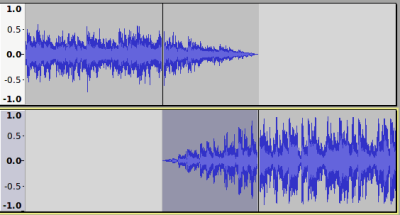
Atmos
Using atmos (recordings of the location sound with no one talking) really can help fix out problems when edits are noticeable because of jumping background sound.
ALWAYS when you record some audio, make sure you record some atmos either before you start or when you finish. Make sure everyone is quiet while you are doing this.
Audio Editing Software
We're showing you the basics of Audacity as it is a free and open source software, there are many other multi track software or DAWS (digital audio workstations) you can use and we've listed a few popular ones below.
- ProTools (Paid)
- Logic Pro X (starting from $600)
- Ableton Live ($99 upwards)
- Adobe Audition ($30 per month subscription)
- Audacity (Free)
- Garageband (Free with Mac)
- Hindenburg ($139)
Audio Editing Basics
Understanding Decibels, Gain and Levels Resources;
https://transom.org/2015/podcasting-basics-part-3-audio-levels-and-processing/ https://www.audiodraft.com/blog/audio-levels-101-all-you-need-is-lufs/ http://www.adobepress.com/articles/article.asp?p=2171314&seqNum=2 https://www.tcelectronic.com/brand/tcelectronic/loudness-explained#googtrans
-16 LUfs is generally the suggested loudness output, Hindenberg software makes this very easy to output at this level.
Audacity
We have chosen Audacity to showcase as it is a Free and Open Source software available on all OS platforms.
Let's go through a basic Audacity software induction so we can understand a few more of the basic tools and what we need to get our new Podcast Intro up to scratch; https://wiki.edgeqld.org.au/doku.php?id=facilities:fablab:software:audacity
Soundbed
Main advice for any audio interviewing is to make sure you record a bed of room tone or atmosphere sound to undercut the whole ep so it sounds even.
Another useful trick is panning 2+ mics slightly to the left and right to give the feeling of being in a room with the podcasters, and using a high pass filter if you have too much noise you can’t clean up.
For your show intro editing, let's find some free backing music and sound effects and edit our vocal recording to piece together a fun podcast sting!
Free music and sound effects resources;
Output File Formats
We always suggest that you record using the WAV format (high-quality, no data compression) even though for the purposes of a podcast your file will be converted to an MP3 or AAC format (lower-quality, data compression). When setting up your session in your audio recording and editing program, the best standards at the lowest size to use are: WAV, 16-bit, 44.1 kHz. (You can record at higher quality but the difference is mostly negligible by the time you export the file as an MP3 or AAC).
Podcasts need to be distributed as data compressed files, and the most widely accepted formats are MP3 and AAC. The quality settings are up to you, but as a guide:
- Music and/or much creative sound? Stereo MP3 at 320kbps
- Essentially just voice? Mono MP3 at 128kbps or even lower can suffice
Smaller file sizes are preferred, so do some tests and go with the lowest encoding rate that still sounds good enough to you. However lower rates will effect much musical material, so if it’s music heavy you should aim for a higher rate.
If your podcast will sound fine in mono (if it is just spoken word), export, and encode, in mono: the resulting file will be only half as big as a stereo version. It’s a good idea to keep the file at 16-bit and 44.1 kHz, and experimenting with different compression settings in your MP3 or AAC encoder, but some voice-only podcasts can sound OK at lower sample rates or bit depths.
The most common file format is MP3, and that’s still the most widely supported by all devices that can play podcasts. AAC is becoming increasingly popular, and those files can be played on the vast majority of devices. AAC offers better audio quality at smaller file sizes, so it’s more efficient to store and to distribute, and it offers some additional metadata that MP3 does not, such as Chapter Markers, embedded links and images. These add-on features are not widely used by podcast listeners though.
Apart from audio quality, the main thing to take into consideration in relation to the size of the file that you are uploading for podcast is bandwidth. Bandwidth, the amount of data used to deliver your audio to the end user, probably won’t be a big problem until your podcast becomes very popular. If you have a few hundred, even a few thousand subscribers, the bandwidth used to send out that audio will likely be covered by the basic contract with your web host or podcast host (depending on where you are putting your audio).
It is definitely worth checking to see what your hosting service provides, and what happens if you do exceed the agreed-upon bandwidth. Costs can increase considerably if you start getting hundreds of thousands of downloads but if you are so successful with your podcast hopefully you will be able to attract advertising!
It’s always a good idea to export and save a full-quality version of your production as an uncompressed WAV file. You may want to make simple changes or updates to your program and in some cases it might be easier to tweak a mixed version than to go back and re-adjust the elements of your original multi-track project. Also, the technology of audio delivery changes, so at some time in the future, you may want to re-encode your production.
The actual encoding of your files can usually be done directly from your editing program: most of them will have an option to export your final mix in a few different formats. Or, you can always export the mix of your show as a WAV file, and use a separate encoding program to convert it to MP3 or AAC.
Distribution
One of the main things people get stuck on when they get started in podcasting, is how to get it out to listeners. There's a few steps to distributing your podcast, and you might want to know straight away how to I get it on iTunes or Spotify, we'll cover this a bit later but the 2 key things are RSS feeds and a hosting service.
Metadata
Metadata is is useful information about your podcast and makes it easier to find your podcast when searching.
You may already know about Metadata as it's displayed in your media playing software (such as iTunes) or on the screen of your MP3 player - such things as Track title, Album, Artist. When you bounce/export audio, software like Audacity will ask you to fill in these fields.
RSS Feeds
RSS stands for “rich site summary” and is a simple way of staying up to date with the delivery of content, for example, tracking episodes of podcast releases. Wiki entry
More on RSS Feeds; https://rss.com/how-to-create-an-rss-feed/
Hosting
There are a variety of hosting services out there, it mainly comes down to cost and ease of use for most people.
- Podbean
- Buzzsprout
- Libsyn
- Transistor
- Simplecast
- Soundcloud
- Podomatic
- Whooshkka
Promotion
Once you have a podcast set up, it's not as easy as just waiting for listeners and followers to find you, you need to get out there and promote the podcast and new content.
Think about creating a website, even if it's a free Wordpress or Blog site.
Think about social media, create a Facebook page, Instagram and Twitter account - but only if you'll use them regularly, as social networks and their algorithms are about continuous engagement. You can't just create a page and then not post regularly, as your audience may not as engage with your content if they don't know what's coming up on the podcast.
Make a media contact list (see if you can find someone who works in a similar area who has one prepared)
Organise cross promo with other podcasts of similar size, plug each others’ shows.
Join facebook groups for fellow podcasters
Have a launch party. Physical events in the real world help to build excitement around your show’s release, and to connect community.
Some more info on effective podcast promotion;
Audience Metrics
Once you start your podcast, you want to track who your listeners are and how they're accessing your podcast. Why? Well firstly, it helps to know you're not just putting out something you've spent a lot of time and energy on and you've got no one listening. Secondly, if you want to make money from your podcast, then you're going have to grow your audience, the best way to grow your audience is to know your audience! With a clearer understanding of your listening audience and the right promotional pushes, you might be able to earn some income.
Depending on your hosting service provider, you should have access to some analytics, like how many listens, where people are located, listening sources (itunes, spotify etc).
Here are some Whooshkaa Insight screen shots;
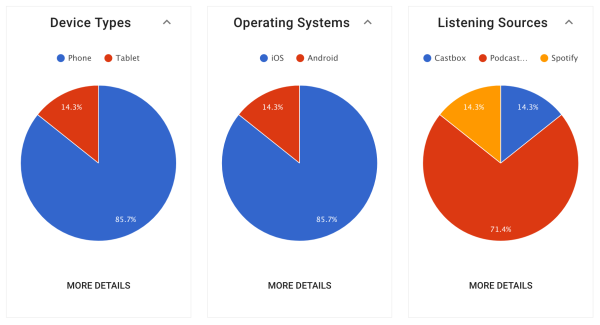
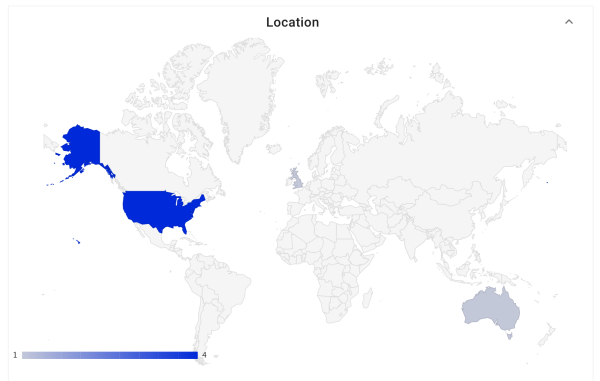
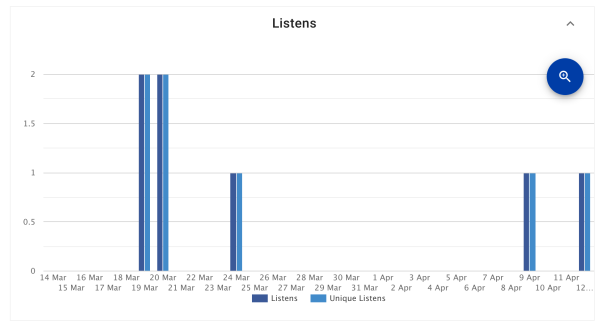
Looking at other podcasters and the most popular podcasts from around the world can help you gain an understanding of what gets the most interest from the general public, however, don't let that stop you from staying in a niche area and not thinking too much about a topic that will appeal to a large demographic, some of the most obscure and self indulgent podcasts have become very popular!
Specific analytics tracking website Podtrac has some really handy and accessible information about measuring analytics for podcasts, and they use a measuring system that is free for podcasters to sign on for and provide monthly rankings - http://analytics.podtrac.com/
Making Money
We just talked a lot about looking at our audience and analytics, and mainly this is what is key to getting a podcast to bring in income. This is a hard thing to achieve, it's a very competitive market with new podcasts popping up every day.
How do you get out on top with so many other diverse and interesting podcasts fighting for the listeners attention? Well when you do start to get a healthy audience, there's the opportunity to bring in sponsors/advertisers. And this is where possibly having a niche topic of podcast can help you target some key aligning sponsors, say for example your podcast was on guitar pedals, well then you've got a good chance of convincing a pedal manufacturing business to come on board as a sponsor - an example one is Mozilla’s IRL.
Another way to make money is to use crowd-funding, and ask straight to the source, the listener, to support by becoming a patron or contributing to a fundraising campaign (Patreon is an example of this).
There's also the opportunity to apply for funding for some more specific areas of podcasting focus, like documentary storytelling and reporting etc. but this is pretty rare still in Australia.
You could start small when you had a good following of loyal supporters and just get some merch produced and sell it!
Affiliate sales programs (amazon, redbubble etc.) are also helpful because they’ll sign almost anyone, you don’t have to have heaps of followers.
Some more resources;
https://www.thebalancesmb.com/how-to-make-money-podcasting-2531432
Wrap Up
That's the end of our Podcasting series, we encourage you to learn more on the areas you may feel less confident in, googling tutorials or using the Lynda training resources. Or, check out some of the more tailored workshops the State Library offer on the website
After this session we hope you'll be ready to go with starting your own podcast! Please keep in touch and let us know when you've launched - appliedcreativity@slq.qld.gov.au
Further Resources
Feel free to join local Facebook group set up for Brisbane Podcasters
Or the Australian group - https://www.facebook.com/groups/australianpodcasters/
Another great resource - http://australianaudioguide.com/